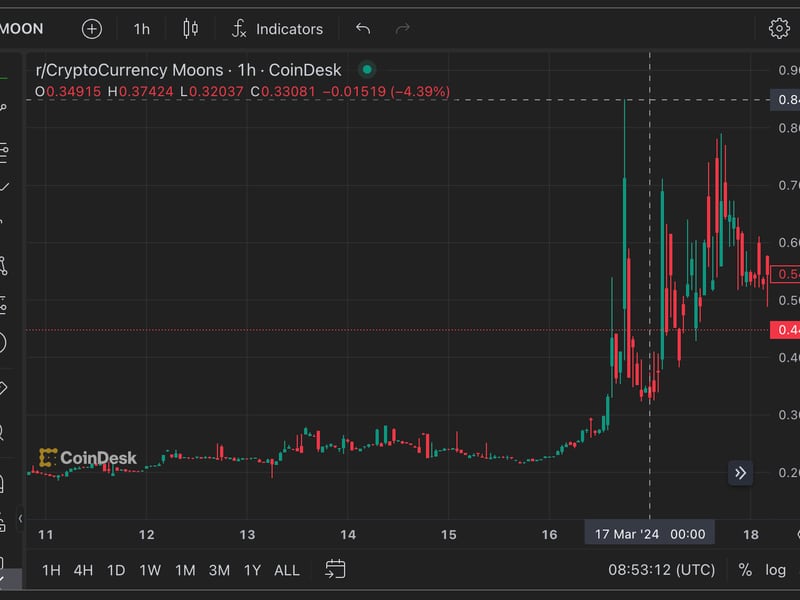Money Reimagined: Demand for USD Stablecoins Foreshadows Financial Disruption
Credit: Shutterstock/Bjoern Wylezich
Money Reimagined: Demand for USD Stablecoins Foreshadows Financial Disruption
Picture a consulting firm with 150 staff worldwide, a global retail chain with a million in-store employees, or a manufacturer that sources high-turnover inventory from more than 50 suppliers in 10 different countries – each an archetype of the global, corporate economy.
What’s the one thing they all need consistent access to? Cash.
That basic need lies at the heart of a global, and potentially transformative, scramble for liquidity as the economic outlook turns dire during the COVID-19 pandemic. Firms want an unbroken, liquid source of funds to make payroll and settle invoices – without which the entire economy goes into toxic shock – and specifically, they want dollars.
The pandemic has unleashed a global race for greenbacks, which when combined with a debt crisis for the world’s banks, could catalyze a sea change in our global payments system with what some are starting to call “crypto dollarization.”
You’re reading Money Reimagined, a weekly look at the technological, economic and social events and trends that are redefining our relationship with money and transforming the global financial system. You can subscribe to this and all of CoinDesk’s newsletters here.
Crypto or not, dollars are the only game in town now. It’s the currency in which debt and assets are denominated worldwide and, because it’s used for cross-border payments, it’s the easiest to get, the most liquid.
The U.S. Federal Reserve is currently facilitating this by opening currency swap lines with other countries’ central banks and providing them with short-term “repo” lending. As I alluded to in last week’s inaugural edition of this newsletter, the Fed will eventually be unable and/or unwilling to be the world’s indefinite lender of last resort, with huge geopolitical ramifications when it withdraws support. But for now, the dollar is king.
Dollarization is combining with a looming debt crisis. This week, Goldman Sachs forecast a staggering 34 percent contraction in first quarter U.S. GDP and the International Monetary Fund said 2020 will be the worst year for the world economy since the Great Depression. The defaults and bankruptcies this will generate are almost unfathomable.
Of course, the world’s governments will try to backstop banks and companies, which is one reason the IMF is forecasting that, globally, net public debt will rise to 85 percent in 2020 from 70 percent last year. Since this entails robbing Peter (taxpayers) to pay Paul (corporate shareholders and bankers), the political tensions unleashed by bailout negotiations will sow acrimony and fear and could undermine confidence in the system.
The banking system is nothing without confidence. It’s built on a fractional reserve model by which banks lend out deposits, which creates new money without the equivalent held in reserve. (Cast your mind to the “It’s a Wonderful Life” speech by the Jimmy Stewart character George Bailey to his savings and loan customers for a reminder of how a loss of confidence can seriously challenge this model.)

When the edifice of confidence looks shaky, a business leader with cash liquidity needs faces a dilemma. Many will hold their noses and continue to bet on the existing system. But anyone who’s lived through, say, Greece’s debt crisis, or Argentina’s currency meltdowns, or any other emerging-market panic might look at the world’s debt numbers with trepidation. Given the post-COVID outlook for banks’ loan customers, some will doubt the security of their deposits, regardless of whether they are denominated in dollars.
What’s a business to do then? They can’t withdraw and hoard cash to protect themselves; banknotes are hardly a viable payments option in the modern world. But perhaps dollar-backed stablecoins pose an option. These carry the bearer instrument qualities of cash, where the right to value is transferred peer-to-peer without an intermediary, based purely on the change in possession. But they also have the capacity to move money globally and securely, all, in theory, without the security risks of the banking system. Since the token issuer commits to hold the full equivalent in reserves for all tokens issued, the fractional reserve system’s perennial question about deposit assurance ceases to be an issue.
Perhaps this is why data since March 1 from CoinMarketCap.com show a striking 40 percent increase in market capitalization of the four largest reserve-backed stablecoins – Tether’s USDT (on Ethereum, Tron and Omni), Centre’s USDC, Binance’s BUSD, and Paxos’s PAX.

First, let’s put this in perspective. Totaling more than $8 billion, the combined number is still just a fraction of bitcoin’s $128.7 billion and is minuscule compared with, say, the $28.5 trillion market cap of all stocks on the New York Stock Exchange. Moreover, the growth in stablecoins could simply reflect a natural crisis-fueled move into stability by exchanges, miners and other big cryptocurrency market players, traditionally the main users of stablecoins.
But other evidence points to something more meaningful. Firstly, the total value traded over the ethereum blockchain, which supports stablecoins such as tether and USDC, has reached parity with bitcoin, according to a chart from Messari based on Coinmetrics data. This number, which aggregates the value of ethereum’s native currency, ether, and that of all ERC-20 tokens built on ethereum, suggests people are increasingly transacting in stablecoins.
Also, there’s this telling comment from Jeremy Allaire, CEO of Circle, which along with Coinbase is one of the two members of the CENTRE consortium that issues and manages USDC tokens. Speaking of demand for a new USDC payments service his company launched for businesses last month, Allaire told our Nikhilesh De:
Examples of new businesses opening accounts span e-commerce marketplaces, advertising networks, luxury goods makers, recruiting platforms, digital content markets, P2P lending and payments companies, software companies, professional services firms, loyalty and rewards businesses, mobile banking providers and other internet services. We believe we are seeing a real turning point in the adoption of digital currency.
If non-crypto businesses are starting to see a mainstream use for stablecoins, Libra’s new move away from a basket-of-currencies model into one-on-one stablecoins could prove well timed. The shift, announced Thursday, seems at least partly intended to mollify regulators’ concerns about the Facebook-founded Libra Association’s capacity to distort national monetary policies. But it could also be a fortuitous time to create a dollar stablecoin.
Libra’s announcement means CENTRE (which issues USDC), Tether, Binance and Paxos could be getting a big new global competitor. Will it stop there? What’s to stop other big players joining the stablecoin business? Mastercard? Visa? (Both are former members of the Libra Association.)
The big question is what this all means for banks themselves and whether they too will join this stablecoin movement?

For some time, advocates for protecting the plumbing of payments from the financial system’s periodic crises, and their accompanying “too-big-to-fail” bailouts, have argued for a “narrow banking” model. You deposit money with your bank, which it invests in super safe securities such as Treasury bills, and the only service it provides is to enable you to make electronic payments with your funds. Under this model, your money is not re-lent into the economy; providing credit is the domain of fund managers and professional investors, not for bankers who simultaneously manage our payments system.
Narrow banking hasn’t taken off for the simple reason that it’s not nearly as profitable as politically backstopped fractional reserve banking. But ultimately, it’s society, not the banks, that should define the system. Maybe now we’ll understand the value of narrow banking – which, in the age of cryptocurrency might essentially means bank-issued stablecoins.
A bigger question is whether fractional reserve banking ultimately survives and, if it doesn’t, what’s the best way to generate the credit our economy needs? Also, how do central bank digital currencies (CBDCs) fit into all this?
These are heady issues, better reserved for a later edition of Money Reimagined.
And, to be clear, it’s early days. Maybe all this will blow over. Also, vested political interests have much to gain from protecting the existing system.
But the COVID-19 crisis is unprecedented. Not even the titans of banking are immune from the pressures it will bring to bear on incumbent institutions.
It’s still a debt crisis
Nic Carter of Castle Island Ventures argued in a tweet last week that “in the next year or so,” we’ll realize the world economy’s crisis isn’t a health crisis but a debt crisis. He’s right. The economic pain from COVID-19 lockdowns would more easily pass if a massive debt overhang weren’t in place. We’d see a temporary supply shock of the kind that accompanies a disaster like a hurricane, where economic activity shrinks but then swiftly rebounds to prior levels as reconstruction begins.

But in this case the pandemic is just the trigger, pushing already unsustainable debt-to-asset levels to a point where central banks can no longer simply reflate away the problem. This IMF map of private debt to GDP shows why this matters: The largest economies, those simultaneously taking the worst COVID-19 hit and upon whose stimulus efforts global recovery depends, are saddled with the biggest burden. It’s why banks are in trouble. It’s why I don’t think the old financial system survives this crisis.
The global town hall
A Bank of England webinar about central bank digital currencies would struggle to compete with Netflix’s and HBO’s offerings in social distancing households. But within my nerdy Twitter feed, last week’s BOE’s presentation generated much buzz. At the outset, fintech director Tom Mutton provided the caveat that the 326-year-old bank has no commitment to launch a CBDC. Still, with COVID-19 effects expected to accelerate CBDC adoption, it was nonetheless worthwhile to garner ideas from an institution that, in 2015, was one of the first to explore the technology. As you can see from the YouTube rerun, it was also peppered with insights from viewers via a series of flash surveys. This one stood out: if CBDCs were to employ distributed ledger technology (read: permissioned blockchains), the power of “programmability” topped the poll as its biggest benefit. “Programmable money” is entering the lexicon, folks.

The digital dollar is baaaaack. Well, at least inside the Washington bubble. After an on-again-off-again appearance in House and Senate stimulus bills last month, the idea of “FedAccounts,” or “Digital Dollar Account Wallets,” reappeared in a radical bill from Congresswomen Rashida Tlaib (D-Mich.) and Pramila Jayapal (D-Wash.). As proposed, digital dollar wallets would be the tool by which the federal government distributes a monthly $2,000 to each resident from the proceeds of a pair of freshly minted $1 trillion coins issued to the Fed. Setting aside the incongruence that hard-money bitcoiners see between monetary alchemy and digital currency technology, what’s bothersome, even for those who believe governments should employ this technology, is that ideas are being rushed without heed to the technical challenges. Former Commodities and Futures Trading Commission chairman J. Christopher Giancarlo, a proponent of digital dollars, couldn’t have been more direct or timely than in his CoinDesk OpEd Thursday, entitled “Digital Dollar Project: Don’t Rush Digital Dollar During COVID-19 Crisis.”
China’s Blockchain Service Network is a game changer. Beijing is determined to use blockchain technology – to be clear, permissioned, not permissionless, blockchains – as the platform for a new, digitally connected economy. Now, details have emerged of a new developer framework for municipal governments and Chinese businesses to employ. CoinDesk’s Wolfie Zhao and David Pan laid out details on the BSN in a richly informative deep dive Tuesday. Open, permissionless, freedom-protecting technology, this is not. But it would be a grave mistake to assume China won’t reap the competitive benefits of a BSN-based programmable economy.
Money Is Losing Its Meaning. So says Jared Dillian of Bloomberg in a column that touches on a rather straightforward but insightful point. Whatever one thinks about central bankers’ power over fiat monetary policy in the post-Nixon Shock era, the public’s faith in money has hinged on an understanding that policymakers are subordinate to the core principle that a currency must be scarce. That is, it’s constrained by something, even if only an institutional obligation to protect its value. Now, with the Fed pledging trillions-of-dollar sums worth of asset buying for an indefinite period, Dillian says, “These numbers are so large that they no longer have any meaning; they are simply abstractions.” Me? I wouldn’t say money itself is losing its meaning. What’s at risk is this particular half-century-old Western conception of money. Inevitably, society will imagine a new money, one that does have meaning. Let the reimagining begin!
Disclosure Read More
The leader in blockchain news, CoinDesk is a media outlet that strives for the highest journalistic standards and abides by a strict set of editorial policies. CoinDesk is an independent operating subsidiary of Digital Currency Group, which invests in cryptocurrencies and blockchain startups.









